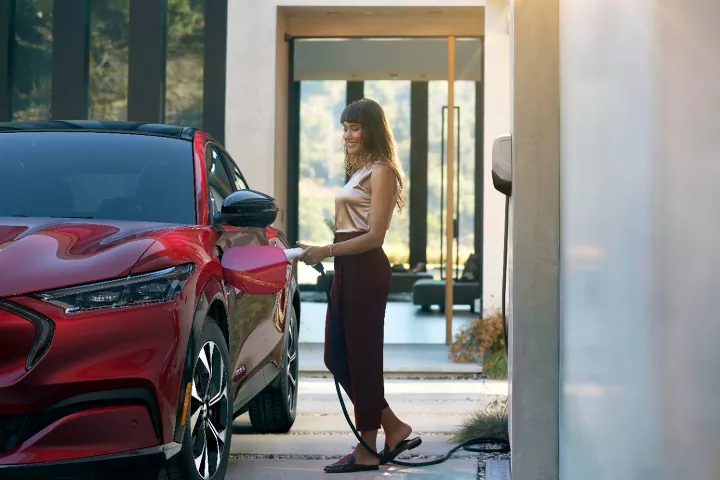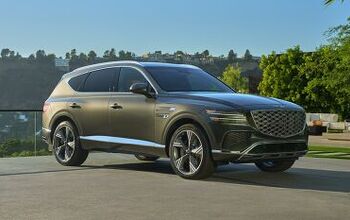Report: Chinese Export Rule Changes Could Impact EV Battery Production

China has reportedly decided to place restrictions on exports of graphite, which could spell trouble for American EV manufacturers. Starting this month, the Chinese government requires permits for certain graphite products being exported. This includes synthetic and natural graphite meeting the necessary thresholds to be used on electric vehicle batteries.
Since most EVs use lithium-ion batteries, one might assume this isn’t a large issue. But graphite actually comprises more than 25 percent of most lithium-ion batteries. It’s an essential component and China is responsible for about 66 percent of the world’s graphite production. We’ve frequently commented on how shifting toward all-electric vehicles inherently benefits China due to it being the world’s largest battery supplier by a significant margin. But the region doesn’t just have the market cornered on completed batteries. China is also responsible for controlling the raw materials needed to construct them in the first place.
In terms of graphite production, no other nation comes close. Mozambique and Madagascar produce 13 and 8.5 percent of the global graphite supply, respectively, while Brazil handles about 6 percent. While Canada and Russia are responsible for about 1 percent a piece, every other nation on the planet represents less than a single percent of the world’s total supply. This effectively makes any U.S. battery supplier reliant upon China for sustained production.
"The amount of graphite needed to feed those gigafactory beasts is in the neighborhood of a million tons per year, and the current capacity is zero in North America at commercial scale," John DeMaio, president of Graphex Group, a graphite processor with roots in Hong Kong, told Automotive News in the relevant report. "It's a wake-up call as to where the supply-demand mismatch is for a very key, critical element in battery manufacturing."
While the Biden administration has bent over backwards to accommodate domestic battery production, this doesn’t really solve issues pertaining to raw materials. It could even be argued that it further advantages Chinese industries while exacerbating environmental concerns by forcing companies to move countless tons of graphite halfway around the world on container ships.
This also complicates the federal EV tax incentive scheme, which is tied to domestic content requirements. Does a vehicle produced in America still qualify for government subsidies if the brunt of the battery pack materials stem from China? How exactly are regulators going to make these determinations? And what’s the point of U.S. leadership demanding that we pivot toward EVs when we don’t have the necessary infrastructure or support or manufacture them domestically?
The author of the Automotive News report explored the topic in a follow up piece. But the article seems wholly dedicated to convincing readers that the United States needs to revamp how mining permits are handled. The key argument used was the domestic need for graphite in regard to EV production. Comparisons were also made with other nations. According to the National Mining Association, permits for activating mines can take 10 years to receive in the U.S. vs just two to three years in Canada and Australia.
From AN:
Ford and Rivian are among auto companies urging the White House to speed up the review process for critical mineral mining. In September, the Biden administration issued a report asking Congress to update the General Mining Act of 1872 and to have federal agencies update their processes to accelerate the permitting process while still upholding high environmental and labor standards.
"To meet the needs of the clean energy economy while respecting our obligations to Tribal Nations, taxpayers, the environment, and future generations, we need a modernized approach to make sure mining in this country is sustainable, responsible and efficient," said Tommy Beaudreau, then-U.S. deputy secretary of the Interior, in a news release.
While Turkey technically has the world’s largest graphite reserves, production has been extremely limited due to a lack of investment. The Alliance for Automotive Innovation (the world’s largest lobbying group for the automotive industry) says China controls roughly 90 percent of global anode production capacity and converts about 90 percent of the world's graphite into anode materials used in batteries.
This leaves Western nations with limited options. Walking back U.S. mining regulations would undoubtedly reduce costs and put the country on the quicker path toward becoming more self reliant. But this still leaves China as an essential battery supplier for the foreseeable future and it’s getting extra choosy about which countries are given access. America simply doesn't have the natural graphite reserves of other nations and sourcing meaningful amounts would take over a decade when/if the raw materials are found.
Though we also don’t know how this is going to play out. China failing to approve exports would likely hurt the bottom line of numerous companies and sour relations. A total crackdown on Western nations hoping to get some graphite seems unlikely. But the country could limit exports, potentially driving up prices in the process over time.
Prices have come down in terms of the smaller flake graphite since 2011. However, large flake graphite offers higher levels of purity and has seen valuations nearly double within the same time frame. It also happens to be the version that’s most commonly associated with battery anode material, meaning demand has predictably increased. While production stalls in 2020 and 2021 exacerbated the problem, worldwide production was already trending down after peaking in 2017. This is curious, as one would expect demand to have encouraged additional mining.
"The same amount of [capital expenditures] is involved in setting up a mine for graphite as it would be for gold or platinum," explained DeMaio. "It's not been hugely profitable in the past. So there's a tremendous amount of graphite on the planet, but not a lot of it is currently being extracted."
Though, until mining surveys prove otherwise, the brunt of that material seems isolated to Asia, Africa, and the Middle East. Canada and Brazil are the only real exceptions located in our hemisphere. But, even if North America did begin sourcing closer to home, China remains the world leader in both graphite processing and battery production. Nobody else even comes close.
Synthetic graphite made from petroleum coke is a possible alternative and something the U.S. is already doing. But China again leads the world here and most battery applications would require a mix of synthetic and natural graphite to function. Unfortunately, synthetic graphite tends to be more expensive and energy intensive to produce. However, advocates remain convinced that its ability to be modified makes it an avenue worth pursuing — theoretically resulting in safer batteries boasting higher capacities for energy storage.
Still, even if synthetic graphite outperforms expectations and future domestic lithium mines produce adequate yields, we’re still left having to secure cobalt. While a minor component in EV battery production, it’s an important one and there’s presently no pathway to accrue more once the planet’s seemingly modest natural supply is exhausted. All this mining has also brought into question just how environmentally sound, ethical, and sustainable EVs truly are, in addition to how their proliferation has started to impact other industries (e.g. steel) reliant on the same resources.
[Image: Ford Motor Co.]
Become a TTAC insider. Get the latest news, features, TTAC takes, and everything else that gets to the truth about cars first by subscribing to our newsletter.

A staunch consumer advocate tracking industry trends and regulation. Before joining TTAC, Matt spent a decade working for marketing and research firms based in NYC. Clients included several of the world’s largest automakers, global tire brands, and aftermarket part suppliers. Dissatisfied with the corporate world and resentful of having to wear suits everyday, he pivoted to writing about cars. Since then, that man has become an ardent supporter of the right-to-repair movement, been interviewed on the auto industry by national radio broadcasts, driven more rental cars than anyone ever should, participated in amateur rallying events, and received the requisite minimum training as sanctioned by the SCCA. Handy with a wrench, Matt grew up surrounded by Detroit auto workers and managed to get a pizza delivery job before he was legally eligible. He later found himself driving box trucks through Manhattan, guaranteeing future sympathy for actual truckers. He continues to conduct research pertaining to the automotive sector as an independent contractor and has since moved back to his native Michigan, closer to where the cars are born. A contrarian, Matt claims to prefer understeer — stating that front and all-wheel drive vehicles cater best to his driving style.
More by Matt Posky
Latest Car Reviews
Read moreLatest Product Reviews
Read moreRecent Comments
- Theflyersfan With sedans, especially, I wonder how many of those sales are to rental fleets. With the exception of the Civic and Accord, there are still rows of sedans mixed in with the RAV4s at every airport rental lot. I doubt the breakdown in sales is publicly published, so who knows... GM isn't out of the sedan business - Cadillac exists and I can't believe I'm typing this but they are actually decent - and I think they are making a huge mistake, especially if there's an extended oil price hike (cough...Iran...cough) and people want smaller and hybrids. But if one is only tied to the quarterly shareholder reports and not trends and the big picture, bad decisions like this get made.
- Wjtinfwb Not proud of what Stellantis is rolling out?
- Wjtinfwb Absolutely. But not incredibly high-tech, AWD, mega performance sedans with amazing styling and outrageous price tags. GM needs a new Impala and LeSabre. 6 passenger, comfortable, conservative, dead nuts reliable and inexpensive enough for a family guy making 70k a year or less to be able to afford. Ford should bring back the Fusion, modernized, maybe a bit bigger and give us that Hybrid option again. An updated Taurus, harkening back to the Gen 1 and updated version that easily hold 6, offer a huge trunk, elevated handling and ride and modest power that offers great fuel economy. Like the GM have a version that a working mom can afford. The last decade car makers have focused on building cars that American's want, but eliminated what they need. When a Ford Escape of Chevy Blazer can be optioned up to 50k, you've lost the plot.
- Willie If both nations were actually free market economies I would be totally opposed. The US is closer to being one, but China does a lot to prop up the sectors they want to dominate allowing them to sell WAY below cost, functionally dumping their goods in our market to destroy competition. I have seen this in my area recently with shrimp farmed by Chinese comglomerates being sold super cheap to push local producers (who have to live at US prices and obey US laws) out of business.China also has VERY lax safety and environmental laws which reduce costs greatly. It isn't an equal playing field, they don't play fair.
- Willie ~300,000 Camrys and ~200,000 Accords say there is still a market. My wife has a Camry and we have no desire for a payment on something that has worse fuel economy.


































Comments
Join the conversation
Simple solution.
Put a chick in it, and make her gay.
Thanks, Matt. While your perspective may favor one "side" a bit, it's a nice (but MUCH smaller) counterpoint to the constant banging-of-the-drum over at Autoblog.